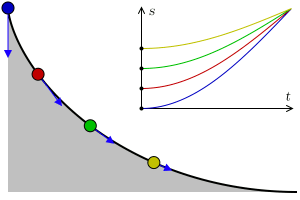

A tautochrone curve or isochrone curve (from Ancient Greek ταὐτό (tauto-) 'same' ἴσος (isos-) 'equal' and χρόνος (chronos) 'time') is the curve for which the time taken by an object sliding without friction in uniform gravity to its lowest point is independent of its starting point on the curve. The curve is a cycloid, and the time is equal to π times the square root of the radius (of the circle which generates the cycloid) over the acceleration of gravity. The tautochrone curve is related to the brachistochrone curve, which is also a cycloid.